Office of the President of the Republic of Taiwan

Corey Lee Bell, Project and Research Officer, Australia-China Relations Institute, University of Technology Sydney |

Elena Collinson, Manager, Research Analysis, Australia-China Relations Institute, University of Technology Sydney |
This article appeared in the Australian Institute of International Affairs' blog, Australian Outlook, on April 18 2023.
The last two weeks have witnessed a milestone in Taiwan’s diplomatic relations. President Tsai Ing-wen ‘transited‘ through the US en route to South America, meeting US House of Representatives Speaker Kevin McCarthy. Meanwhile, former leader Ma Ying-jeou concluded a 12-day tour of mainland China.
While these trips perhaps reflect an attempt by Taipei to increase the island’s diplomatic space, they have also brought into relief a more sombre reality – that the debate about Taiwan’s future has emphatically shifted from a cross-Strait affair between Beijing and Taipei to a cross-Pacific affair between Beijing and Washington.
The Tsai-McCarthy meeting – A Beijing-Washington dispute
It is worth noting the strength of the rhetorical and military responses from Beijing to the April 6 meeting between Taiwan’s independence-leaning President Tsai and US Speaker McCarthy. Only Beijing’s aggressive response to former US Speaker Nancy Pelosi’s visit to Taipei in August last year surpassed it in scale, the intensity of which had led several commentators to label it the Fourth Taiwan Strait Crisis.
Beijing’s rhetorical threats are increasingly targeting the US, along with Taiwan. The chargé d’affaires at China’s embassy in Washington warned the meeting between Tsai and McCarthy could prompt ‘another serious confrontation in the China-US relationship.’ This coincided with a spate of Chinese state media articles warning Americans of the costs of a war with China.
Put another way, meetings between Taiwanese and US officials, as opposed to domestic measures adopted by Taiwanese authorities, have prompted the most belligerent responses from Beijing.
Ma’s China visit – Beijing’s Taiwan downgrade
The notion that Taiwan is being talked over in debates about its future to some degree resonates with the distinction between Beijing’s response to Tsai’s US visit, and its lukewarm welcome to former pro one-China advocate Ma.
Ma’s concurrent trip to China marked the first trip of a former Taiwanese leader to the Chinese mainland since the Republic of China’s (ROC) government fled the mainland after losing the civil war to communist forces in 1949.
Yet in spite of this historical significance, the visit was decidedly low key. There was no red carpet welcoming Ma, and no meetings with high-level leaders. This is in distinct contrast to precedents afforded to Taiwan’s former vice president, Lien Chan, who had met Hu Jintao and Xi Jinping, and inspected Chinese troops in a military parade in Beijing.
Even Ma’s attempt at bridge-mending was tepidly met. Not for the first time, Ma emphasised the vibrancy of his native Hong Kong, whose ‘one country, two systems’ model has long been promoted as a template for a ‘unified’ Taiwan. But Beijing itself undermined this message, with high-profile Taiwan specialists in the National Party Congress proposing in the lead up to the visit that Taipei may need to accept ’one country, one system.’
Taiwan – a marginalised voice in the debate on its own future
The diplomatic downgrade for Ma, and China’s military intimidation over Tsai’s US transit, combined to send a pointed message: Taiwan is in no position to dictate the terms of what Beijing calls its ‘reunification’; all that stands in the way of Beijing’s ambitions is Washington.
Previously, US strength made the prospects of unification by force relatively untenable, and Beijing saw negotiating with Taiwan as the only viable avenue for pursuing unification.
Today, however, Beijing is a bona fide economic and military superpower, and sees American power as declining. At the same time, public opinion surveys have revealed that Taiwanese support for unification with China has markedly trended downwards in recent decades. With the backing of America seen as wavering in strength and/or determination – and with China, facing demographic headwinds which could constrain its growth and power in coming decades – Beijing sees less incentive to entertain Taiwanese recalcitrance, let alone allow the island to dictate the terms of a post-unification political order.
Indeed, as a PLA Air Force retired major-general said in 2020, ‘no matter how much we emphasise that the Taiwan problem pertains to China’s domestic affairs, it remains, in essence, a problem between China and America.’ He added, ‘the crux of resolving the Taiwan problem does not lie in tackling Taiwan independence forces, but lies instead in addressing the comparative strength of China and the US.’
The evolving threat of conflict
Yet there are other reasons for the shift in emphasis to Washington.
Chinese sources have long alleged that America is ‘emboldening’ ‘independence forces’ in Taiwan by showing support for the island. But high-level US-Taiwan meetings, as well as widening military cooperation, is prompting a growing concern that America is using ‘salami slicing tactics’ to strengthen ties with Taiwan in a way that undermines its one-China policy while gradually making the island a forward operations base for ‘containing China.’ For Beijing, the latter crosses a red line.
It is the conflation of those nagging older fears and newer, more alarming ones that is prompting Beijing to up the ante on high-level meetings between American and Taiwanese officials. This is in turn motivating a shift from the older language of denouncements towards a vocabulary of ultimatums, making Washington a direct target.
At the same time, Beijing’s heated rhetoric is pushing Washington into a corner. Washington needs to retain the confidence of its allies and partners that it will not back down in the face of threats from Beijing if it is to retain its regional standing.
What this means is that a conflict in the Taiwan Strait involving the world’s two superpowers, and potentially US allies such as Australia, may not necessarily be the product of an ‘accident’ or ‘miscalculation,’ nor the untamed ambition of a Chinese autocrat. It could instead come from that most anachronistic of causes – that both sides occupy positions from which neither can back down.
To the extent that this is the case, it is a problem that guardrails or protocols alone may not be able to address. Across the series of mini-crises in the last few years, much weight has been loaded on expectations that Washington and Beijing will step back from the precipice, when what has been needed are blunt bilateral discussions on how they keep getting there.
Authors
Dr Corey Lee Bell is a Project and Research Officer at the Australia-China Relations Institute, University of Technology Sydney.
Elena Collinson is head of analysis at the Australia-China Relations Institute, University of Technology Sydney.


